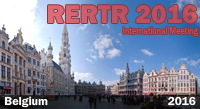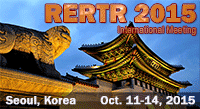Examples of LEU Conversion Analyses in the RERTR Program
ANALYSES FOR CONVERSION
OF THE GEORGIA TECH
RESEARCH REACTOR FROM HEU TO LEU FUEL
J.E. Matos, S.C. Mo, and W.L. Woodruff
RERTR Program
Argonne National Laboratory
September 1992
SUMMARY
This report contains the results of design and safety analyses performed by the RERTR Program at the Argonne National Laboratory (ANL) for conversion of the Georgia Tech Research Reactor (GTRR) from the use of HEU fuel to the use of LEU fuel. The objectives of this study were to: (1) maintain or improve upon the present reactor performance and margins of safety, (2) maintain as closely as possible the technical specifications and operating procedures of the present HEU core, and (3) utilize a proven fuel assembly design that is economical to manufacture. Extensive collaboration with Dr. R. Karam, Director of the Neely Nuclear Research Center at Georgia Tech, took place on all aspects of this work.
The LEU fuel assembly has the same overall design as the present HEU fuel assembly, except that it contains 18 fueled plates with LEU U3 Si2 -Al fuel instead of 16 fueled plates with HEU U-Al alloy fuel. This LEU silicide fuel has been approved by the Nuclear Regulatory Commission for use in non-power reactors.
Documents that were reviewed by ANL as bases for the design and safety evaluations were the GTRR Safety Analysis Reports, the GTRR Technical Specifications, and responses by the reactor organization to AEC questions in licensing the reactor for 5 MW operation.
The methods and codes that were utilized have been qualified using comparisons of calculations and measurements of LEU demonstration cores in the Ford Nuclear Reactor at the University of Michigan and in the Oak Ridge Research Reactor at the Oak Ridge National Laboratory. Additional qualification has been obtained via international benchmark comparisons sponsored by the IAEA for heavy water research reactors.
Only those reactor parameters and safety analyses which could change as a result of replacing the HEU fuel in the core with LEU fuel are addressed. The attached summary table provides a comparison of the key design features of the HEU and LEU fuel assemblies and a comparison of the key reactor and safety parameters that were calculated for each core. The results show that all of the objectives of this study were fully realized and that the GTRR reactor facility can be operated as safely with the new LEU fuel assemblies as with the present HEU fuel assemblies.
SUMMARY TABLE
HEU and LEU Design Data, Core Physics, and Safety Parameters
for Conversion of the Georgia Tech Research Reactor
| DESIGN DATA | HEU Core | LEU Core |
| Minimum Number of Fuel Assemblies | 14 | 14 |
| Maximum Number of Fuel Assemblies | 19 | 19 |
| Fuel Type | U-Al Alloy | U3Si2 -Al |
| Enrichment, % | 93 | 19.75 |
| Uranium Density, g/cm3 | 0.65 | 3.5 |
| Number of Fueled Plates per Assembly | 16 | 18 |
| Number of Non-Fueled Plates per Assembly | 2 | 2 |
| 235 U per Fuel Plate, g | 11.75 | 12.5 |
| 235 U per Fuel Assembly, g | 188 | 225 |
| Fuel Meat Thickness, mm | 0.51 | 0.51 |
| Cladding Thickness, mm | 0.38 | 0.38 |
| Cladding Material | 1100 Al | 6061 Al |
| Number of | |||
| REACTOR PARAMETERS | HEU Core | LEU Core | Assemblies |
| Cold Clean Excess Reactivity, % Dk/k | 11.7 ± 0.4 | 9.4 ± 0.4 | 17 |
| Coolant Temperature Coefficient, % Dk/k/°C | -0.0076 | -0.0067 | 14 |
| Doppler Coefficient, % Dk/k/°C | ~ 0.0 | -0.0017 | 14 |
| Whole Reactor Isothermal Temp. Coeff., % Dk/k/°C | -0.0224 | -0.0232 | 14 |
| Coolant Void Coefficient, % Dk/k/% Void | -0.0383 | -0.0333 | 14 |
| Limiting Power Peaking Factor | 1.54 | 1.58 | 14 |
| Prompt Neutron Lifetime, ms | 780 | 745 | 14 |
| Effective Delayed Neutron Fraction | 0.00755 | 0.0075-0.0076 | 14 |
| Shutdown Margin, % Dk/k | -7.1 ± 0.2 | -8.8 ± 0.2 | 17 |
| (Max. Worth Shim Blade and Reg. Rod Stuck Out) | |||
| Top D 2 O Reflector Worth, % Dk/k | -2.1 ± 0.3 | -2.4 ±0.3 | 17 |
| (For D 2 O 2" Above Fuel Meat) | |||
| Reactor Power Limits -1625 gpm Flow Rate | |||
| Based on Departure from Nucleate Boiling, MW | 11.5 | 10.8 | 14 |
| Based on Flow Instability Criterion, MW | 10.6 | 10.6 | 14 |
| Limiting Reactor Inlet Temperature, °F | 172 | 170 | 14 |
| Limiting Reactor Outlet Temperature, °F | 188 | 187 | 14 |
| Limiting Safety System Settings - Forced Convection | |||
| Reactor Power, MW | 5.5 | 5.6 | 14 |
| Coolant Flow Rate, gpm | 1625 | < 1625 | 14 |
| Reactor Outlet Temperature, °F | 139 | 145 | 14 |
| Margin to D2O Saturation Temperature, °F | 8 | 11 | 14 |
| Max. Fuel Plate Temp. for LOCA after 8 Hours Cooling, °C | 425 | 400 | 14 |
| Maximum Positive Reactivity Insertion, % Dk/k | > 2.2 | > 2.2 | 14 |
![]() PDF version available
PDF version available
DOWNLOAD full paper in PDF format.
Contact:
Dr. James E. Matos
Senior
Physicist
Argonne National Laboratory
9700 S. Cass Ave., Bldg. 207
Argonne, IL 60439-4841 USA
Tel.: +1-630-252-6758
Fax: +1-630-252-5161
![]()




